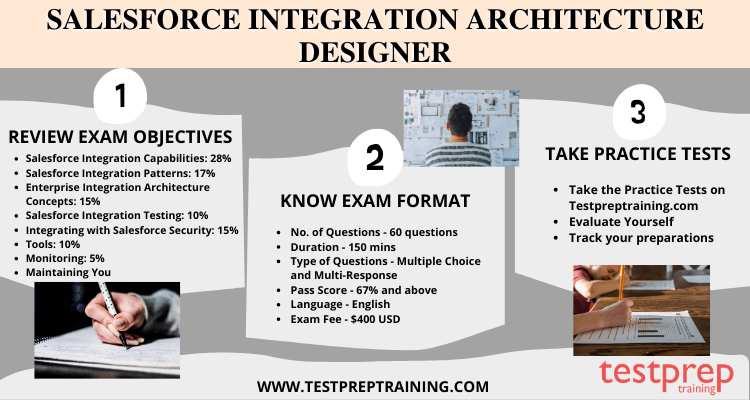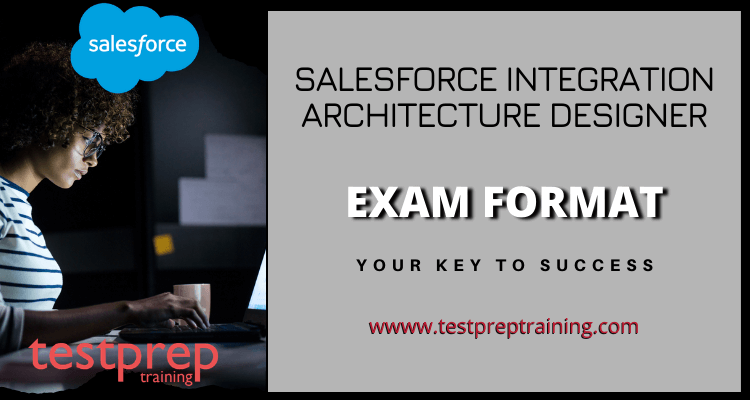Are you preparing for Salesforce Integration Architecture Designer Exam? Don’t know how to start? Well in this article we have got you covered with all the related exam details and learning resources that will help you prepare better. Moreover, it is very important to have everything in-check so that you are well prepared for the exam. Let’s then start to gather all the related exam details.
Salesforce Integration Architecture Designer: Exam Overview
Salesforce Integration Architecture Designer exam is for anybody who wants to examine the architecture environment, requirements, and develop solid and scalable technical solutions on the Salesforce Platform to fulfill end-to-end integration needs. It’s for architects, analysts, and application managers who want to create Lightning Platform interactions that are both safe and scalable. Additionally, it demonstrates the candidate’s capability to effectively convey technical solutions to technical stakeholders and provide a project delivery framework that ensures quality and success.
Who should take the exam?
A Salesforce Integration Architecture Designer’s job role is to evaluate the integration requirements needed to secure the designs, scalable solutions for combining the Salesforce Platform. The designer has to also experience designing and implementing intricate integration models on various platforms, as well as communicating the solution and design trade-offs to business and technical stakeholders alike. It will also consist of developing and maintaining the integration architecture blueprints for projects, integrating with the other enterprise cloud applications, architecting robust, scalable security mechanisms for interfaces, and following the best domain practices in integration.
Salesforce Integration Architecture Designer Exam Format
- Firstly, you’ll need to plan your strategy to prepare for and tackle the Salesforce Integration Architecture Designer Exam effectively.
- The maximum allowed time for the exam is 105 minutes.
- There are a total of 60 questions in the exam.
- The questions are of the multiple-choice/multiple-select type, providing several options for each question. You can use the elimination method to choose the correct option(s).
- No negative marks are deducted for wrong answers, allowing you to take educated guesses.
- The exam fee for Salesforce Integration Architecture Designer Certification is $400, and local taxes apply.
Salesforce Integration Architecture Designer Course Outline
The Salesforce Integration Architecture Designer Course covers the following topics –
1. Evaluate the Current System Landscape: 8%
- Firstly, Given a set of business requirements, identify the current system landscape and determine what standards, limitations, boundaries and protocols exist.
- Secondly, Given an existing system landscape, analyze for constraints and/or pain-points to satisfy a business requirement(s).
- Thirdly, Given a set of requirements, evaluate the authentication and authorization needs based on the system landscape.
2. Evaluate Business Needs: 11%
- Given a use case, identify functional and non-functional requirements needed for integration.
- Based on a given integration requirement, identify and classify data into Confidential/Secure/Public.
- Given a use case, identify key factors for CRM success that should be included as integration requirements.
- Given a use case, identify the business growth and regulatory factors that can impact choice of integration solutions.
3. Translate Needs to Integration Requirements: 22%
- Further, Given an existing system landscape diagram, create an inventory of the systems and integration patterns.
- Moreover, Given a use case and business process, evaluate system and process constraints.
- Likewise, Given a use case, identify integration security / authentication / authorization requirements.
- Given a use case, identify performance needs (volumes, response times, latency) and propose appropriate integration solutions that will meet business requirements.
4. Design Integration Solutions: 28%
- Given a use case, identify the integration pattern that meets business requirements.
- Additionally Given a use case, define the components which create a solution that meets business requirements.
- Given a use case, identify the trade-offs, limitations, and constraints that meet the proposed solution.
- Also, Given a use case that includes technical requirements, constraints or drivers, specify the appropriate Salesforce API(s) for the proposed solution.
- Given a use case that includes technical requirements, constraints or drivers determine the standards, components, techniques, and security mechanism that should be used.
5. Build Solution: 23%
- Furthermore, Given a use case that includes technical requirements, constraints or drivers, identify the considerations when designing and implementing API(s), both Salesforce as an API provider and Salesforce as an API consumer.
- Given a use case, identify the considerations when choosing the right option in making an outbound call to an external system.
- Eventually, Given a use case, describe what should be considered when building a scalable solution
- Given a use case, determine error handling for different integration options
- Moreover, Given a use case, create a security solution for inbound or outbound integrations
- Given a use case, identify the factors needed to build resilience in an integration solution for system updates.
7. Maintain Integration: 8%
- Given an integration maintenance use case, identify performance monitoring needs for integration requirements.
- In addition to, Given a use case, identify the appropriate error handling, escalation and recovery procedures for a failed integration.
- Finally, Given a use case, identify reporting needs for integration monitoring.
Learning Resources for the Salesforce Integration Architecture Designer Exam
Grabbing the best and the most suitable learning resource is the most crucial step for any preparation. Your rate of success in the exam depends upon the selection of study materials to a great extent. You should also go through your course outline effectively as it will help you a lot in deciding how much time you need to give to a particular topic. It plays a key role. Having reasonable information on your syllabus will surely help you to create a strong mindset regarding the preparation. So, lets start with our Salesforce Integration Architecture Designer Study Guide

Further, you can join an online community for the preparation, as it is very flexible and will surely maximize, you’re learning. You can exchange ideas, can create meaningful relationships, and also a sense of belonging. You can also go for instructor-led training. It is very interactive and that can help you a lot with the preparation. It will provide you with personalized learning. Also, you will also get a chance to learn some new things from your mates. You should also appear for practice tests. It will help you to revise your syllabus and will also let you know how much you have prepared. Some of the critical learning resources include –
1. Salesforce Study Guide
The study guide is the next step in the study guide for the Salesforce Integration Architecture Designer exam. Head to the official Salesforce website to access the study guide for the Salesforce Integration Architecture Designer exam. Salesforce strongly advises a mix of practical experience, attending courses, and self-directed study for optimal preparation and success in the exam.
2. Salesforce Integration Architecture Designer Trailhead
Trailhead is the most important aspect of your preparation guide when it comes to Salesforce. Trailheads are indeed valuable and practical tools when getting ready for an exam. By utilizing Trailhead, you can explore online documentation, tip sheets, and user guides. Additionally, you can search for subjects outlined in the exam guide, focusing on the information associated with those topics.
3. Salesforce Integration Architecture Designer Training
Indeed, gaining some hands-on experience is the most significant experience for exams like Salesforce Marketing Cloud Administrator. Unlocking success in the exam lies in the Training Course. You can explore various training courses provided by Salesforce to prepare effectively. They offer candidates a range of options to choose from. Additionally, consider checking out online tutorials and study guides for comprehensive guidance.

Experts’ Corner
The benefit of holding this certificate is that you will always be up-to-date on the new product releases and updates. For the job role such as technical architect, application manager, solution architect, etc. this certification is must-have. It will give a solid and mandatory boast to your career. To clear the exam, you need to prepare well and give should try your hands in Salesforce Integration Architecture Designer Practice Exams. It decides your rate of success in the exam. Also, it is proven that practice tests are one of the most beneficial ways to prepare for any professional exam.


